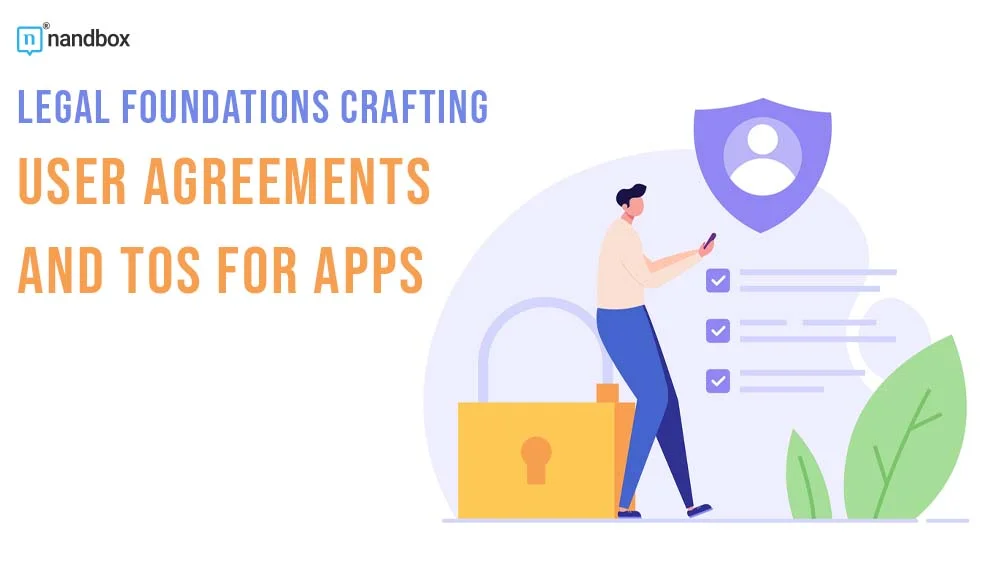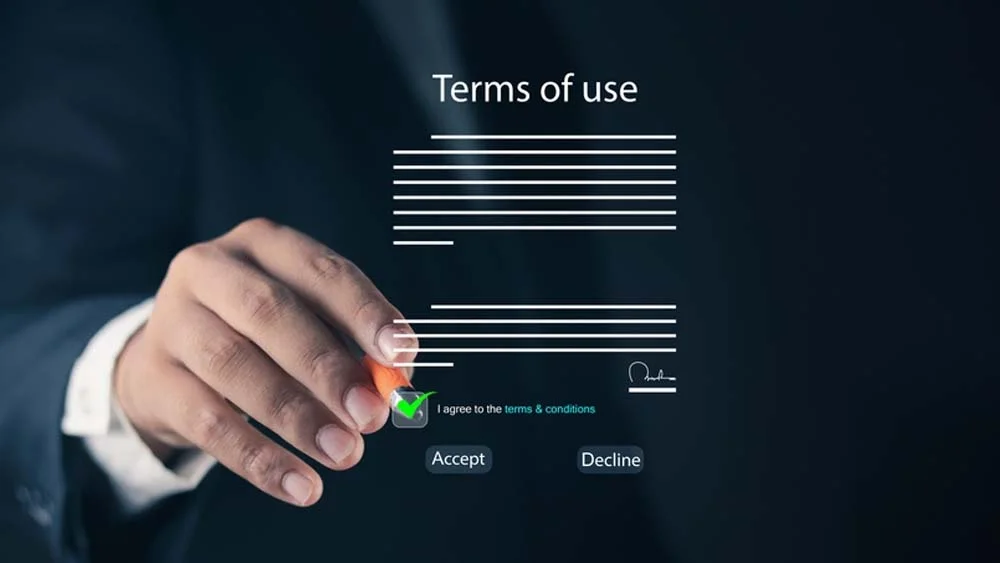User agreements and terms of service (also known as ToS) are vital for mobile app developers. They serve as protective measures for developers and users. Crafting legally sound user agreements and ToS involves multiple components and considerations to ensure clarity, fairness, and legal compliance.
Key Points:
- User agreements and TOS protect both developers and users.
- Essential components include user rights, developer obligations, and dispute resolution.
- Clarity, fairness, and legal compliance are paramount.
- Regular updates and user notifications are necessary.
- User agreements must clearly outline user rights and responsibilities, covering account creation, usage permissions, and content ownership. They should also include sections on acceptable use, detailing prohibited behaviors like spamming or hacking. They can also specify ownership and usage rights for user-generated content.
Limit Liability With Your Terms of Service
Developers must also state their obligations, such as maintaining app functionality, providing support, and protecting user data. Setting realistic expectations about app performance and availability is crucial, including disclaimers to limit legal liability for issues beyond the developer’s control, like third-party service failures.
Kip Mutati, emphasizes the importance of clarity and transparency in these agreements. “Ensuring users understand their rights and the app’s limitations builds trust and reduces the likelihood of disputes,” he notes.
Privacy policies, often referenced in the terms of service, must explain what data is collected, how it’s used, and with whom it’s shared. Transparency here builds trust and ensures compliance with privacy laws like GDPR and CCPA. If the app includes purchases, payment terms should be clearly outlined, as should pricing, and billing cycles. Additionally, refund policies should be explained. Users should be aware of their rights regarding cancellations and refunds.
Another critical section is dispute resolution, specifying how conflicts will be handled through arbitration, mediation, or courts and outlining the process and any associated costs. Including a class action waiver can prevent collective lawsuits. It’s essential to reserve the right to update the ToS as needed, informing users of changes through email or in-app notifications and ensuring they don’t retroactively affect users without explicit consent.
Building Effective User Agreements and ToS for Mobile Apps
The circumstances under which user accounts can be terminated. For instance, it will detail violations of the ToS, inactivity, or illegal activities, as well as explain the consequences of termination, such as losing access to app content or services. Ensuring the terms of service comply with relevant laws is essential, which might involve consulting legal experts to understand obligations under different jurisdictions, primarily if the app operates globally. Compliance helps avoid legal issues and maintains user trust.
Writing the ToS in clear, straightforward language is paramount. Avoid legal jargon that might confuse users, and use bullet points and headings for better readability. This makes the document accessible and understandable. Tailoring the ToS to your specific app rather than relying on generic templates helps cover unique features or functionalities. This provides a comprehensive agreement that covers all potential scenarios.
Regularly reviewing and updating the ToS to reflect changes in the app or laws is necessary, perhaps annually or bi-annually, to ensure the document stays relevant and effective in protecting both the developer and users. When updates occur, notifying users promptly and providing a summary of significant changes and how they affect users helps maintain transparency and trust. Ensuring users actively accept the terms of service, typically through a checkbox during account creation or updates. It provides a robust defense in legal disputes by demonstrating that users know their rights and obligations.
Set the Governing Law and Jurisdiction
Including clauses that limit the developer’s liability for damages is common. As it covers direct, indirect, or consequential damages arising from app use. These limitations must be reasonable and legally enforceable. Specifying the governing law and jurisdiction for the ToS is particularly important for international apps. It clarifies which laws apply and where disputes will be resolved, providing certainty for both users and developers.
Encouraging users to provide feedback on the ToS and offering support channels can help identify unclear sections and improve the document over time. Ensuring the ToS can be enforced through monitoring app usage for compliance and taking action against violations. It is critical to maintain the integrity of the terms and the app’s ecosystem.
Intellectual property rights within the terms of service should be clarified. This includes the app’s code, design, and content, specifying what users can and cannot do with this intellectual property. This protects your creative and technical investments while respecting user rights. If your app is accessible to children, provisions to comply with laws like COPPA should be included, including obtaining verifiable parental consent for users under 13 and ensuring content and interactions within the app are appropriate for younger audiences.
Ensuring Legal Soundness in Mobile App User Agreements and ToS
For apps used globally, addressing international legal considerations, such as data transfer regulations, is essential. Tailoring the ToS for different regions helps ensure compliance and user satisfaction. Transparency in the ToS builds trust with users by clearly explaining why each section is included and how it benefits them. Effective communication within the app, making the ToS easily accessible through settings or a dedicated section, reinforces its importance and encourages adherence.
Consider including precedents or case studies that illustrate how the ToS has been applied. You can provide practical examples to help users understand the terms’ implications. Educating users on the importance of reading and understanding the ToS can lead to better compliance and fewer disputes.
Working closely with legal experts when drafting the terms of service ensures the document is legally sound and comprehensive. It anticipates potential legal challenges and addresses them proactively. Striving for balance and fairness in the ToS is crucial, as overly restrictive terms can deter users, while overly lenient terms might not provide adequate protection. Aiming for a middle ground that respects both parties’ interests is ideal.
Try to Get Consent When Possible
Consider the design of the ToS document, with straightforward typography, sufficient spacing, and intuitive navigation enhancing readability. A well-designed document reflects professionalism and care. Ensuring the ToS integrates seamlessly with other policies, like privacy policies and community guidelines, prevents contradictions and provides a cohesive user experience.
User consent is fundamental, and explicitly obtaining consent ensures users agree to the terms knowingly. It serves as a defense in legal disputes. A clear process for handling ToS violations, including warnings, temporary suspensions, or permanent bans, and communicating. This process to users helps them understand the consequences of violating the terms.
Continuously improving the ToS based on user feedback and evolving legal standards keeps the document adequate and relevant. Regular updates signal that the developer is proactive and attentive to changes. Keeping thorough records of all versions of the ToS and user consent can be crucial in resolving disputes and demonstrating compliance with legal requirements.
Formulating Legal User Agreements and Terms of Service for Mobile Apps
If your app serves non-English speakers, providing translations of terms of service ensures all users understand their rights and obligations, fostering inclusivity and compliance. If your app integrates with third-party services, addressing this in the ToS clarifies how third-party terms might affect users and what happens if those services change or terminate, preventing confusion and setting clear expectations.
Alistair Vigier of ClearwayLaw says “If your app uses advertising, including terms related to ad content and user targeting, explain how user data is used for advertising purposes and ensure compliance with relevant advertising laws and regulations. Outlining the security measures to protect user data builds trust and reassures users about their data’s safety.”
Clearly defining user responsibilities promotes a healthy and secure app environment. This includes maintaining the security of their accounts, reporting issues, and respecting other users. Specifying the legal remedies available to both parties in case of disputes, including the right to seek damages, injunctive relief, or other legal actions, helps resolve disputes efficiently.
How Users Can Reach Your Support Team
If your app has a social or community aspect, including community guidelines in the ToS promotes respectful and constructive user interactions. Detailing the technical support provided, ensures users know what help they can expect. This includes how users can reach support, what issues are covered, and any limitations.
Ensuring the terms of service comply with app store requirements. Such as those from Apple’s App Store or Google Play, is necessary. Non-compliance can lead to app removal, affecting the distribution and user access. Environmental and ethical considerations, such as commitments to sustainable practices or ethical data use, can enhance your app’s reputation and appeal to conscious consumers.
Detailing the enforcement mechanisms for the ToS ensures the terms are not merely symbolic but actively upheld. Explaining the impact of ToS violations on users and the app, such as disruption of service or loss of data, emphasizes the importance of compliance and the consequences of non-compliance.





